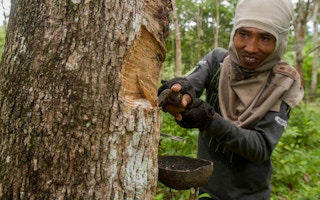Rapid global deforestation and the mounting pressure on Indigenous Peoples’ ancestral forested lands pose a significant threat to our planet’s health.
The inadequate documentation and recognition of Indigenous Peoples’ land and communal rights compound the issue, jeopardizing our ability to meet the Paris climate goals. With a growing body of research clarifying the link between Indigenous Peoples’ tenure rights and decreased deforestation, it is imperative to accelerate tenure efforts if climate targets are to be met.
Amid this challenge lies a remarkable opportunity. Scaling up proven and new geospatial and forest monitoring technologies can enable Indigenous Peoples to demarcate their lands, collect vital information, and establish the groundwork for reclaiming their rights. Unlocking this potential can be a game-changer in our collective efforts to protect the world’s forests and combat climate change.
In this context, Indigenous organisations and communities are employing disruptive technologies that empower them to drive and manage their own land and resource data. With training, user-friendly tools, and the co-creation of adapted systems, Indigenous communities can gather the digital data required for legal land claims while also mapping and monitoring their resources in real-time.
These technologies allow communities to monitor and track potential threats to their land—such as mining, logging, forest fires, drug trafficking, and encroachments—enabling them to safeguard their territories more quickly and effectively.
“
The call to action is clear – scale up the use of technologies and the local capacity needed to map and secure tenure rights on the five billion hectares of undocumented Indigenous Peoples’ forested lands.
One example of this type of partnership has been developed in India, where local NGOs and tribal communities are spearheading an initiative to secure community forest rights. These communities are leveraging geographic information system (GIS) technology to strengthen land tenure security and contribute to climate protection endeavours in Odisha state. Integrating GIS-based mapping technology, training, and capacity-building initiatives provides crucial evidence for community land claims under the Indian Forest Rights Act.
This partnership aims to map and document 50,000 hectares across 400 communities, safeguarding the rights of 200,000 individuals and 40,000 tribal families.
Similarly, in the Peruvian Amazon, the Awajún and Asháninka Indigenous communities are deploying tools, technology, and real-time data to address rapid deforestation. Technology to collect local data and link it to earth-sensing databases enhances the community’s ability to monitor their biodiversity and combat illicit activities, such as illegal logging and drug trafficking, to safeguard 11,000 hectares of rainforest, sequestering 5 million tonnes of carbon.
In Kawthoolei, Myanmar, the Karen Environment Social Action Network (KESAN) is combatting rampant conflict and deforestation to strengthen the Karen Indigenous Peoples’ land and forest rights. They are leveraging technology to streamline the mapping and data management process, protect vital information, and empower the Karen community to reclaim expropriated lands, contest court decisions, and safeguard ancestral territories.
While technology is a powerful enabler, it is not a silver bullet. Global climate funds must flow to Indigenous Peoples to support forest protection. Voluntary carbon funds, the Green Climate Fund, and other multilateral funds should actively contribute to land demarcation and registration programs.
Recognizing and securing land rights is pivotal for climate mitigation, but they require action by governments often challenged with inadequate land administration systems and services. Government systems must embrace flexible, fit-for-purpose approaches and engage with Indigenous Peoples collaboratively to secure tenure at scale.
Inter-agency coordination and data sharing that respects Indigenous data autonomy are central to this effort. Various sectors, including forestry, mining, and park services, must communicate effectively with the government’s land administration system and the data coming from Indigenous Peoples and the organisations that support them. This bottom-up approach complements top-down efforts, fostering a more inclusive and comprehensive approach to land management.
National land administration systems and regulations must evolve, recognise communal Indigenous-managed lands, and embrace diverse systems in line with traditional practices. This recognition ensures a harmonious coexistence of modern governance and Indigenous traditions.
The call to action is clear—scale up the use of technologies and the local capacity needed to map and secure tenure rights on the five billion hectares of undocumented Indigenous Peoples’ forested lands.
By 2035, this ambitious goal should be within reach. Cadasta and its Indigenous partners are actively working on scaling up their efforts. We extend an invitation to others to join us in this crucial endeavour. Together, we can harness the power of technology, data, and Indigenous Peoples’ stewardship to preserve our forests, protect community rights, and secure a sustainable future for our planet.
This story was published with permission from Thomson Reuters Foundation, the charitable arm of Thomson Reuters, that covers humanitarian news, climate change, resilience, women’s rights, trafficking and property rights. Visit https://www.context.news/.



















